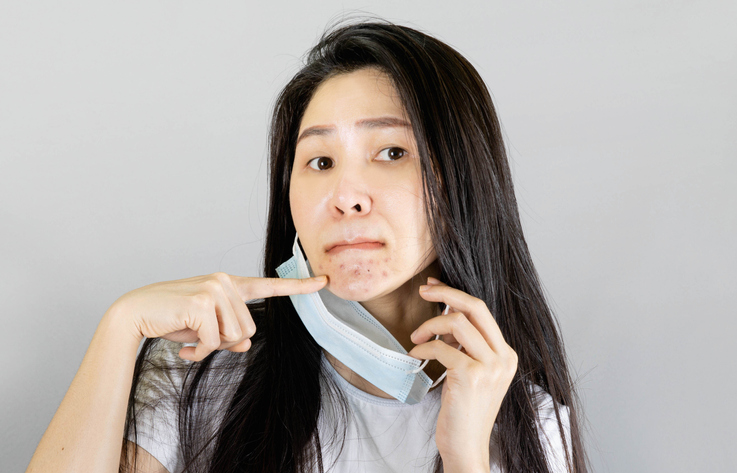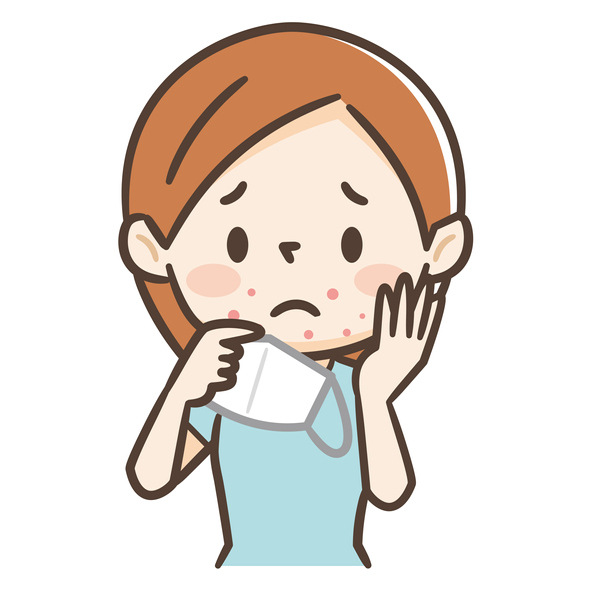How To Combat “Maskne”

By Joy Stephenson-Laws, J.D., Founder
Along with perhaps some strange tan lines, you may be noticing another unwanted side effect of regularly wearing your face mask - acne!
“While vital to protect yourself and others from COVID-19, face masks are causing an uptick in acne. The humid and sticky environment your mask creates around your face lends itself to breakouts around the nose, cheeks, mouth and chin,” reports Northwestern Medicine.
Cleverly coined “maskne,” you may be experiencing this yourself even if you don’t normally suffer from breakouts. And if you are already prone to breaking out and battling acne, well this certainly doesn’t help!
Kyle Laws, a Chilltonic therapist and general manager, said he never dealt with acne in his life until he started wearing a face mask. He is now 27.
“I have had huge breakouts on my chin and cheeks,” he said. “Mostly smaller bumps but also some cystic acne.”
In order to keep himself and others protected, Kyle has to wear a face mask while working. He wears the mask between six to eight hours a day and alternates between cloth and disposable masks.
Acne can also be exacerbated by stress, which so many of us are experiencing extra amounts of lately.
“On a scale of one to 10, my stress level lately has been anywhere between a four to 10,” Kyle said.
Stress may increase cortisol (“the stress hormone”) levels, which can lead to excess oil production in the skin and inflammation - a perfect recipe for acne along with the bacteria that can breed on your face from wearing a mask. To add insult to injury, you may have added stress just from seeing the pimples pop up on your face. It’s as if your stress has stress!
The good news is that we can be proactive about “maskne.”
Kyle said he successfully utilizes Cryo T-Shock facials to address his breakouts.
First, what is Cryo T-Shock?Cryo T-Shock involves the use of a handheld device (used by a professional technician) that delivers alternating “thermal shocks” of thermography (heat therapy) and cryotherapy (cold therapy). Reportedly, "the application of heat and cold speeds lymphatic drainage to clear skin and
tissues." This process significantly increases "micro circulation triggered by the application of hot and cold procedures."
The combination of the hot and cold is apparently beneficial to combating acne because it shrinks pore size, increases circulation, removes toxins and enhances the ability of the skin to utilize oxygen and other nutrients. All this results in less inflammation.
“I don’t really use products on my face except a good soap,” Kyle said. “Cryo T-Shock has helped get rid of all my acne.”
(For more information on Cryo T-Shock and where to get a free consultation, click here).
Additional ways to fight the dreaded "maskne."
If using a reusable face mask, it is important to wash it regularly.
Following a healthy, nutrient-rich diet and drinking plenty of water is also essential to maintaining healthy skin.
“Some studies show an association between acne and high-glycemic-load diets that include a lot of sugar, sodas, juices, white bread, pasta, and heavily processed cereals. Small research trials showed less acne when people eat a low-glycemic-load diet, or a diet with plenty of whole foods, rich in fruits and vegetables, and low in processed and refined products,” reports Harvard Medical School.
This makes sense, because processed foods promote inflammation and natural, whole foods are anti-inflammatory. Some evidence has shown there is also a connection between consuming dairy and acne. There is no definitive connection, however, see what works for you. Really think about what you are eating and how that has an effect on your skin. If you eat a lot of dairy and suffer from acne, try cutting it out for a week or two and see if your condition improves.
Drinking enough water is also key for hydrating the skin properly, flushing out toxins, carrying nutrients and oxygens to the cells and preventing constipation (which can contribute to acne and skin issues).
“In addition to Cryo T-Shock, eating clean and drinking about a gallon of water a day really helps,” Kyle said.
You may not need to drink a gallon, however, strive for at least eight 8-ounce glasses a day. If your urine is clear or pale yellow, you are most likely hydrated. If it is very yellow or almost brown, this is definitely an indication that you are not well hydrated.
Steer clear of drinking too much alcohol and caffeine, which can dehydrate you as well as increase cortisol.
Maintain nutritional balance.Having an adequate intake of nutrients, essential vitamins and minerals, is key in preventing and treating acne and just having overall healthy skin.
For example, some studies have found an association between vitamin D deficiency and acne. I highly advise taking routine nutrient tests in order to determine if you have any nutrient imbalances or deficiencies. If you do, a competent healthcare professional can work with you on making the necessary dietary changes and recommend quality supplements if necessary.
Manage your stress.I know this is easier said than done, but stress can really wreak havoc on your skin and body. Not only may chronic stress cause zits, it may also weaken your immune system. Do whatever you can to make time for yourself and relax whether that involves taking a bubble bath with aromatherapy, doing a little yoga, going for a hike or reading a book.
Also keep in mind that many dermatologists are now taking virtual appointments if you feel your acne is out of control and you need some additional help.
We got this!
Enjoy your healthy life!
Disclaimer: This article is not intended to provide medical advice. Please consult with your doctor or another competent healthcare practitioner to get specific medical advice for your situation.
The pH professional health care team includes recognized experts from a variety of health care and related disciplines, including physicians, attorneys, nutritionists, nurses and certified fitness instructors. This team also includes the members of the pH Medical Advisory Board, which constantly monitors all pH programs, products and services. To learn more about the pH Medical Advisory Board, click here.







